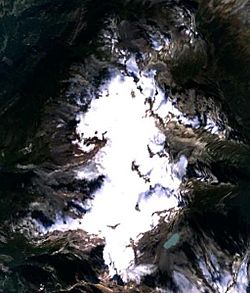Powder Mountain Icefield facts for kids
The Powder Mountain Icefield, also called the Powder Mountain Icecap and the Cayley Icefield, is a glacial field in the Pacific Ranges of southwestern British Columbia, Canada, about 20 kilometres (12 mi) west of Whistler and about 90 kilometres (56 mi) north of Vancouver. On the west side of the icefield is the valley of the Squamish River, while on its east is the Callaghan Valley, which is the setting for the Nordic facilities for the 2010 Winter Olympics.
The icefield is studded by several volcanic formations, including the active Mount Cayley massif. Other summits are Powder Mountain, Brandywine Mountain and Mount Fee. Mount Callaghan, a dormant volcano, is just northeast of the icefield. Mount Brew is just to its south.
Geology
Numerous subglacial eruptions beneath the Powder Mountain Icefield have formed many distinctive subglacial volcanoes in the Mount Cayley volcanic field and contain abundant glass and fine-scale jointing from rapid cooling of lava, such as Ember Ridge and Slag Hill. Mineralogically, the volcanics range from andesite to rhyodacite, and chemically, the rocks span a range from andesite to dacite. Glassy volcanic rocks are abundant, with glass contents as high as 70%. Volcanoes such as the Slag Hill tuya were formed when magma intruded into and melted a vertical pipe in the overlying Powder Mountain Icefield. The partially molten mass cooled as a large block, with gravity flattening its upper surface, forming its flat-topped, steep-sided subglacial volcanic edifice. The latest volcanic activity in the Powder Mountain Icefield has occurred in the past 10,000 years.


